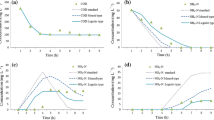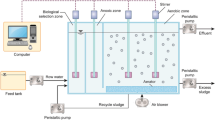Abstract
Soluble microbial products (SMPs) are considered as the main organic components in wastewater treatment plant effluent from biological wastewater treatment systems. To investigate and explore SMP metabolism pathway for further treatment and control, two innovative mechanistically based activated sludge models were developed by extension of activated sludge model no.3 (ASM3). One was the model by combining SMP formation and degradation (ASM3-SMP model) processes with ASM3, and the other by combining both SMP and simultaneous substrate storage and growth (SSSG) mechanisms with ASM3 (SSSG-ASM3-SMP model). The detailed schematic modification and process supplements were introduced for comprehensively understanding all the mechanisms involved in the activated sludge process. The evaluations of these two models were demonstrated by a laboratory-scale sequencing batch reactor (SBR) operated under aerated/non-aerated conditions. The simulated and measured results indicated that SMP comprised about 83% of total soluble chemical oxygen demand (SCOD) in which biomass-associated products (BAPs) were predominant compared with utilization-associated products (UAPs). It also elucidated that there should be a minimum SMP value as the reactive time increases continuously and this conclusion could be used to optimize effluent SCOD in activated sludge processes. The comparative results among ASM3, ASM3-SMP and SSSG-ASM3-SMP models and the experimental measurements (SCOD, ammonia and nitrate nitrogen) showed clearly the best agreement with SSSG-ASM3-SMP simulation values (R = 0.993), strongly suggesting that both SMP formation and degradation and SSSG mechanisms are necessary in biologically activated sludge modeling for municipal wastewater treatment.





Similar content being viewed by others
References
Barker DJ, Stuckey DC (1999) A review of soluble microbial products (SMP) in wastewater treatment systems. Water Res 33(14):3063–3082
Jarusutthirak C, Amy G (2007) Understanding soluble microbial products (SMP) as a component of effluent organic matter (Efom). Water Res 41(12):2787–2793
Rittmann BE, Bae W, Namkung E, Lu CJ (1987) A critical evaluation of microbial product formation in biological processes. Water Sci Technol 19(3–4):517–528
Rittmann BE, Huck PM (1989) Biological treatment of public water supplies. Crit Rev Environ Sci Tech 19(2):119–184
Henze M, Gujer W, Mino T, van Loosdrecht M (2000) Activated sludge models ASM1, ASM2, ASM2d and ASM3. IWA Scientific and Technical Report no. 9. IAW Publishing, London
Benu JJ, Paletta F, van Loosdrecht MCM, Heijnen JJ (2000) Stoichiometry and kinetics of poly-β-hydroxybutyrate metabolism in aerobic, slow growing activated sludge cultures. Biotechnol Bioeng 67(4):379–389
Karahan-Gül Ö, van Loosdrecht MCM, Orhon D (2003) Modification of activated sludge no.3 considering direct growth on primary substrate. Water Sci Tech 47(11):219–225
Krishna C, van Loosdrecht MCM (1999) Substrate flux into storage and growth in relation to activated sludge modeling. Water Res 33(14):3149–3161
Jiang T, Myngheer S, De Pauw DJW, Spanjers H, Nopens I, Kennedy MD, Amy G, Vanrolleghem PA (2008) Modelling the production and degradation of soluble microbial products (SMP) in membrane bioreactors (MBR). Water Res 42(20):4955–4964
Lu SG, Imai T, Ukita M, Sekine M, Higuchi T, Fukagawa M (2001) A model for membrane bioreactor process based on the concept of formation and degradation of soluble microbial products. Water Res 35(8):2038–2048
Lu SG, Imai T, Ukita M, Sekine M, Higuchi T (2002) Modeling prediction of membrane bioreactor process with the concept of soluble microbial product. Water Sci Tech 46(11–12):63–70
Sin G, Guisasola A, De Pauw DJW, Baeza JA, Carrera J, Vanrolleghem PA (2005) A new approach for modelling simultaneous storage and growth processes for activated sludge systems under aerobic conditions. Biotechnol Bioeng 92(5):600–613
Oliveira-Esquerre KP, Narita H, Yamato N, Funamizu N, Watanabe Y (2006) Incorporation of the concept of microbial product formation into ASM3 and the modeling of a membrane bioreactor for wastewater treatment. Braz J Chem Eng 23(4):461–471
Saroj DP, Duglielmi G, Chiarani D, Andreottola G (2008) Modeling and simulation of membrane bioreactors by incorporating simultaneous storage and growth concept: an especial attention to fouling while modeling the biological process. Desalination 221:475–482
Ni BJ, Yu HQ (2008) Growth and storage process in aerobic granules grown on soybean wastewater. Biotechnol Bioeng 100(4):664–672
Fan J, Lu SG, Qiu ZF, Wang XX, Li WZ (2009) An activated sludge model based on activated sludge model number 3 for full-scale wastewater treatment plant simulation. Environ Technol 30(7):641–649
Logan BE, Jiang Q (1990) Molecular size distributions of dissolved organic matter. J Environ Eng 116(6):1046–1062
Logan BE, Wagenseller GA (2000) Molecular size distributions of dissolved organic matter in wastewater transformed by treatment in a full-scale trickling filter. Water Environ Res 72(3):277–281
APHA (1999) Standard Methods for the Examination of Water and Wastewater (20th edition). American Public Health Association, Washington DC
de Silva DGV, Rittmann BE (2002) Nonsteady-state modeling of multispecies activated-sludge processes. Water Environ Res 72(5):554–565
Sobol IM (1993) Sensitivity analysis for non-linear mathematical model. Math Model Comput Exp 1:407–414
Vanrolleghem PA, Insel G, Petersen B, Sin G, De Pauw D, Nopens I, Dovermann H, Weijers S, Gernaey K (2003) A comprehensive model calibration procedure for activated sludge models. In: Proceedings 76th annual WEF conference and exposition. Los Angeles, USA, October 11–15
Hulsbeek JJW, Kruit J, Roeleveld PJ, Van Loosdrecht MCM (2002) A practical protocol for dynamic modeling of activated sludge systems. Water Sci Technol 45(6):127–136
Corominas Ll, Sin G, Puig S, Dolors Balaguer M, Vanrolleghem PA, Colprim J (2011) Modified calibration protocol evaluated in a model-based testing of SBR flexibility. Bioproc Biosyst Eng 34:205–214
Takacs I, Patry GG, Nolasco D (1991) A dynamic model of the clarification-thickening process. Water Res 25(10):1263–1271
Laspidou CS, Rittmann BE (2002) A unified theory for extracellular polymeric substances, soluble microbial products, and active and inert biomass. Water Res 36(8):2711–2720
Majone M, Massanisso P, Ramadori R (1998) Comparison of carbon storage under aerobic and anoxic conditions. Water Sci Tech 38:77–84
Noguera DR, Araki N, Rittmann BE (1994) Soluble microbial products (SMP) in anaerobic chemostats. Biotechnol Bioeng 44(9):1040–1047
Rittmann BE, McCarty PL (2001) Environmental biotechnology: principles and applications. McGrawHil1, New York
Acknowledgments
This study was sponsored by China Shanghai Pujiang Program (07pj14026) and China Shanghai Leading Academic Discipline Project (B506).
Author information
Authors and Affiliations
Corresponding author
Rights and permissions
About this article
Cite this article
Fan, J., Ding, Y., Qiu, Z. et al. Development of mechanistically based model for simulating soluble microbial products generation in an aerated/non-aerated SBR. Bioprocess Biosyst Eng 34, 1151–1161 (2011). https://doi.org/10.1007/s00449-011-0566-3
Received:
Accepted:
Published:
Issue Date:
DOI: https://doi.org/10.1007/s00449-011-0566-3




